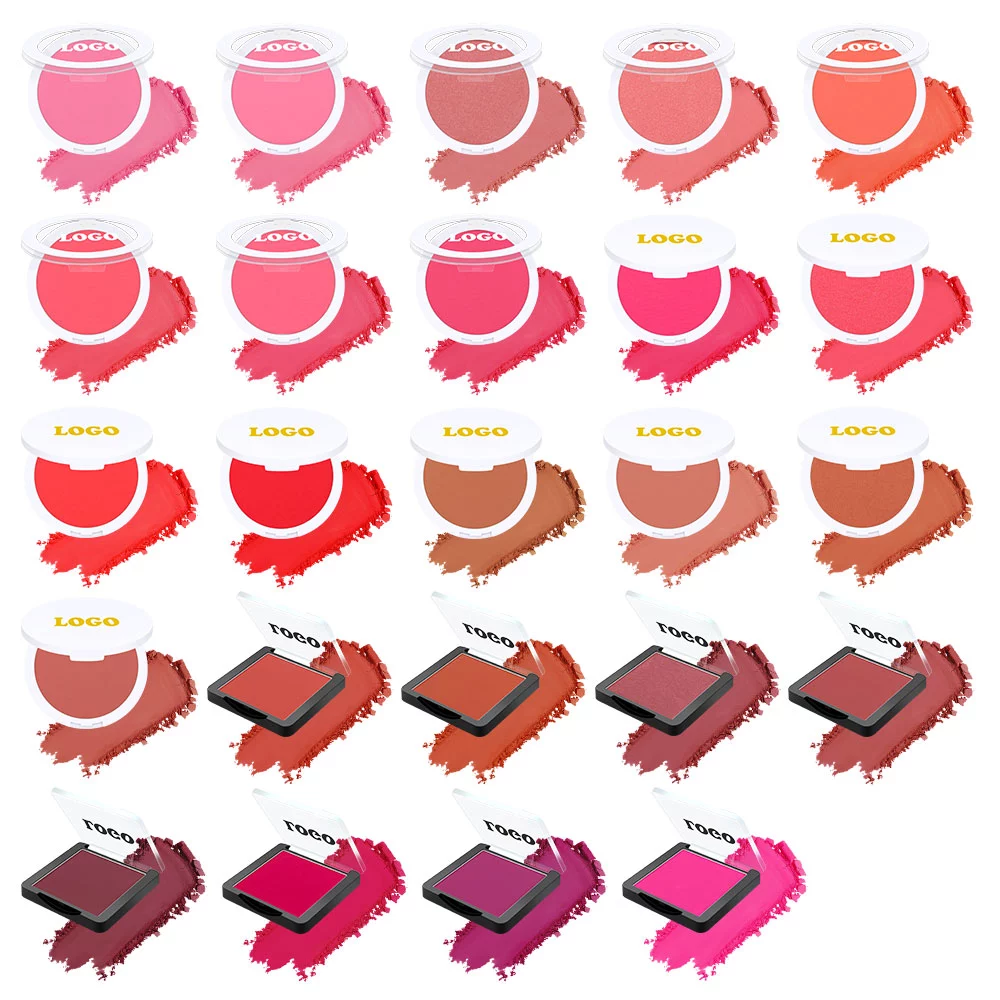Why Blush Color Matters for Your Look
 Ouqian
Ouqian
 Jun 27,2025
Jun 27,2025
Powder blush isn’t just an extra step in your makeup—it can completely change how your face looks. A good blush adds warmth, freshness, and shape to your cheeks. It helps you look more awake, more youthful, and even healthier. But choosing the wrong blush color can make your skin look off-tone or unnatural. So it’s important to find a shade that complements your skin, not competes with it.
First Step: Know Your Skin Tone and Undertone
Before picking any makeup shade—especially blush—you need to know two things:
Skin tone: How light or dark your skin is. Usually grouped into:
Fair/light
Medium
Olive
Deep/dark
Undertone: The subtle hue beneath your skin. It stays the same even if your skin tans.
Cool = pink, red, or bluish tones
Warm = yellow, peach, or golden tones
Neutral = a mix of both
Quick tip to check undertone:
Look at your wrist in natural light:
Blue/purple veins = cool
Green veins = warm
Can’t tell = likely neutral
You can also try the jewelry test: gold looks better on warm tones, silver on cool.
Best Blush Colors for Fair Skin
If your skin is fair, it can be easy to go overboard with blush. Stick to light, soft shades to keep it natural.
Cool undertones: Light pinks, baby pink, and soft rose work great. They mimic a real flush.
Warm undertones: Choose peachy-pink or light coral tones with a soft golden finish.
Avoid dark or super bold blushes—they can look patchy or clownish on fair skin.
Extra tip: If you burn easily in the sun, that’s a sign of cool undertones—use a soft pink blush to mimic that natural flush!
Best Blush Colors for Medium Skin
Medium skin tones are very flexible with color. You can go bright, soft, warm, or rosy.
Cool undertones: Go for berry, mauve, or rose. These add depth without clashing.
Warm undertones: Coral, terracotta, and peach are perfect. They brighten the skin and look sun-kissed.
Neutral undertones: You can wear almost anything, but dusty pinks or peach-pink shades are especially flattering.
Pro tip: Medium skin looks great with blushes that have a soft shimmer. They catch the light and give your cheeks a glow.
Best Blush Colors for Olive Skin
Olive skin has natural greenish or golden tones that need careful balance. Some blushes can look too cool or muddy.
Go for warm peach, soft terracotta, or muted coral shades.
Golden bronze tones and rosy-tan colors also work well.
Avoid super cool pinks or lavender—they may look grayish or too stark.
Seasonal tip: In summer, olive skin glows with orange-toned or bronze blush; in winter, try a rosy nude for softness.
Best Blush Colors for Deep Skin
Deeper skin needs rich, intense shades to stand out and look natural. Pale colors often disappear or turn ashy.
Cool undertones: Deep plum, berry, wine, or rich raspberry are perfect.
Warm undertones: Go bold with red, burnt orange, tangerine, or even brick red.
Neutral undertones: Try fuchsia, magenta, or warm cherry red.
Glow-up tip: Deep skin pairs beautifully with shimmer blushes in gold or copper. They highlight your cheekbones and make your skin look radiant.

Want to Try Something Different?
Blush doesn’t always have to be pink! Trying unique shades can take your look to the next level.
Lavender or lilac: Great for cool-toned fair skin. Looks soft and modern.
True red: When blended well, it mimics a real flush on most skin tones—especially deep.
Orange or tangerine: Bright and fun for medium and dark skin tones.
Yellow: Pastel yellow can work as a color corrector or brightener on fair skin.
Trend tip: Monochromatic makeup is in! Match your blush to your lipstick or eyeshadow for a fresh look.
Choose the Right Texture for Your Skin
The finish of your blush matters as much as the color.
Powder blush: Best for oily or combination skin. Easy to build and blend. Great for matte finishes.
Cream blush: Best for dry or mature skin. Gives a fresh, dewy finish. Apply with fingers or a sponge.
Liquid blush: Very natural-looking and long-lasting. Ideal for “no-makeup” makeup looks.
Blush stains: Super long wear, but you need to work quickly—once it sets, it’s hard to move!
Layering tip: You can layer cream or liquid blush under a powder one to make it last longer!
Easy-to-Wear Blush Shades for Everyone
If you're overwhelmed by choices, try these universal shades:
Rosy pink: Works on almost every skin tone. It’s soft, natural, and easy to wear.
Peach: Adds warmth and glow. A safe choice if you’re unsure of your undertone.
Berry or wine: When applied lightly, even deep colors can look good on lighter skin. Build intensity as needed.
Everyday tip: Keep one peachy shade for day looks and one deeper shade for night or events.
Tips for Natural Blush Application
Smile to find the apples of your cheeks
Start small: use just a little, then build it up
Blend well: brush upward toward your temples for a lifted effect
Too much blush? Tap on a bit of face powder or foundation to tone it down
Check in natural light: it helps you spot any harsh lines or unblended spots
Placement tip: Apply a tiny bit across the nose bridge too—for a cute, sun-kissed vibe.
Blush is one of the easiest ways to add color and life to your face, but it works best when it’s the right match for your skin. Learn your skin tone, know your undertone, and don’t be afraid to try new shades or textures. The perfect blush doesn’t just sit on your skin—it blends in like it belongs there.
As a leading cosmetics factory, we specialize in crafting on-trend
blush makeup tailored to your brand’s vision. Contact us today to discuss your next product line!
 Ouqian
Ouqian
 Jun 27,2025
Jun 27,2025
